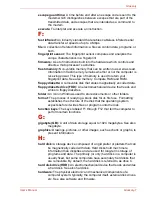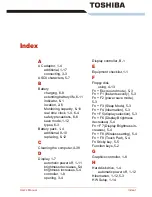
User’s Manual
Glossary-3
Glossary
adaptor:
A device that provides a compatible connection between two
units. For example, the computer’s internal display adapter receives
information from the software and translates it into images on the
screen. An adapter can take a number of forms, from a
microprocessor to a simple connector: An intelligent adapter (one
that is capable of doing some processing) may also be called a
controller.
alphanumeric:
Keyboard characters including letters, numbers and other
symbols, such as punctuation marks or mathematical symbols.
alternating current (AC):
Electric current that reverses its direction of flow
at regular intervals.
analog signal:
A signal whose characteristics such as amplitude and
frequency vary in proportion to (are an analog of) the value to be
transmitted. Voice communications are analog signals.
application:
A group of programs that together are used for a specific task
such as accounting, financial planning, spreadsheets, word
processing and games.
ASCII:
American Standard Code for Information Interchange. ASCII code is
a set of 256 binary codes that represent the most commonly used
letters, numbers, and symbols.
B:
backup:
A copy of a file, usually on a removable disk, kept in case the
original file is lost or damaged.
binary:
The base two number system composed of zeros and ones (off or
on), used by most digital computers. The right-most digit of a binary
number has a value of 1, the next a value of 2, then 4, 8, 16, and so
on. For example, the binary number 101 has a value of 5. See also
ASCII.
BIOS:
Basic Input/Output System. The firmware that controls data flow
within the computer. See also firmware.
bit:
Derived from “binary digit”, the basic unit of information used by the
computer. It is either zero or one. Eight bits is one byte. See also
byte.
Bluetooth:
A short-range radio technology designed to simplify wireless
communication among computers, communication devices and the
Internet.
board:
A circuit board. An internal card containing electronic components,
called chips, which perform a specific function or increase the
capabilities of the system.
boot:
Short for bootstrap. A program that starts or restarts the computer.
The program reads instructions from a storage device into the
computer’s memory.
boot disk:
See system disk.
bootable disk:
See system disk.
bps:
Bits per second. Typically used to describe the data transmission
speed of a modem.
Содержание SATELLITE L310
Страница 1: ...TOSHIBA Satellite M300 L310 Satellite Pro M300 L310 Portable Personal Computer User s Manual ...
Страница 34: ...xxxiv User s Manual Preface ...
Страница 52: ...1 18 User s Manual Introduction ...
Страница 74: ...2 22 User s Manual The Grand Tour ...
Страница 134: ...5 8 User s Manual The Keyboard ...
Страница 152: ...7 4 User s Manual HW Setup ...
Страница 190: ...9 24 User s Manual Troubleshooting ...
Страница 194: ...A 4 User s Manual Specifications ...
Страница 200: ...C 4 User s Manual Wireless LAN ...
Страница 220: ...Glossary 14 User s Manual Glossary ...
Страница 224: ...Index 4 User s Manual Index ...
















































